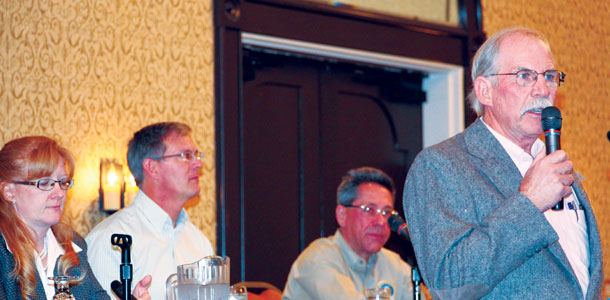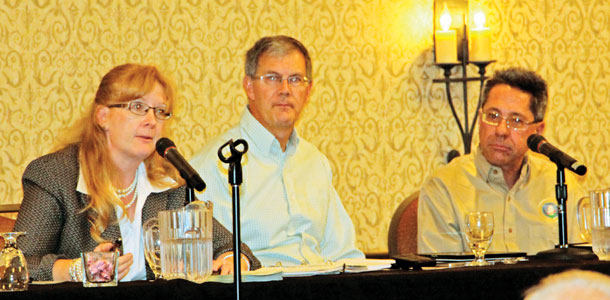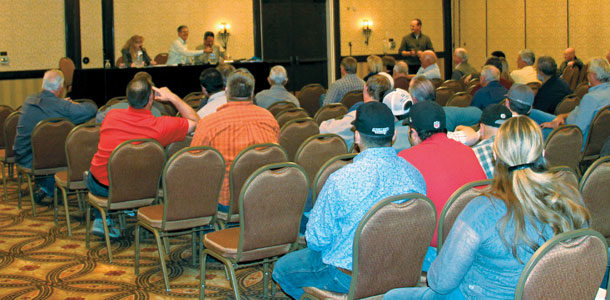More than 130 dairy producers filled the Double Tree Hotel Ballroom in Modesto, California, on Jan. 17 to be updated on the proposed creation of a Federal Milk Marketing Order (FMMO) in California. Golden State dairy producers were invited to interact with a trio of USDA representatives who traveled to California to gather more information and meet with producers.
Rien Doornenbal, an Escalon dairyman, was instrumental in organizing the meeting, having learned of the proposal through his local milk cooperative. While not a new debate, dairymen and women from across the state have been accustomed to a very unique milk marketing system, with its quota system and different milk standards. Most seemed ready to hear about, if not act upon, a new FMMO.
Doornenbal opened the meeting by simply stating, “Every dairyman deserves the opportunity to hear this information.”
He, of course, was referring to the process California producers need to go through in order to change their current milk pricing system into a new FMMO. Currently there are 10 established orders in the country.
Rien quickly turned the meeting over to Dana Coale, deputy administrator for the USDA, who was joined by Will Francis of the Order Formulation and Enforcement Group and Bill Wise, market administrator for the Pacific Northwest and Arizona FMMOs. Coale, who led most of the discussion, gave a straight-to-the-point dissertation of the legalities of forming an FMMO in California.
Growing up on a farm in Iowa, Coale is now responsible for dairy programs, market news, mandatory price reporting, grading and standards, and overseeing both the checkoff and FMMO programs.
 “We have been studying the current milk pricing system in California for quite a while now and find it a truly unique situation,” she said. “While many of you are used to dealing with your cooperatives where change can take place in as quickly as 60 days, the formal process of creating an FMMO can take well over a year.”
“We have been studying the current milk pricing system in California for quite a while now and find it a truly unique situation,” she said. “While many of you are used to dealing with your cooperatives where change can take place in as quickly as 60 days, the formal process of creating an FMMO can take well over a year.”
Coale explained that California Dairies Inc., Land O’Lakes and Dairy Farmers of America have all expressed a unified interest in pursuing a federal order and will be drafting a proposal to submit to the USDA. The next steps are outlined as:
• The USDA issues a notice of hearing
• Proponents request USDA data
• Witnesses submit testimony in advance
• The USDA holds a public hearing
• The USDA makes hearing record available
• Parties file corrections to transcript
• Participants file post-hearing briefs
• The USDA issues a recommended decision
• Parties file comments and exceptions to recommended decision
• The USDA issues a final decision
• The USDA holds a referendum and implements the amendments
Bottom line … it’s a detailed and painstaking process. And it’s going to be a while before an FMMO becomes official in California. Coale mentioned repeatedly that the long timetable to get an order passed for California is because the state has such a unique system in place and also because with any proposal to the USDA, every idea, angle and possibility must be considered.
“One thing I want you to understand is the voting process in this whole scenario,” Coale explained. “It is very specific, and many don’t fully understand what it takes to approve something like this.
Approval can be reached by either two-thirds of the participating producers voting in favor of it or producers representing two-thirds of the volume of milk produced by those participating in the referendum.
If a proposal fails on numbers, then the USDA will look to measure the volume, but we will only count on the producers participating. “As I’ve said before, this whole process is in your hands.”
Some producers were concerned with losing California “standards” and stated that people “buy California milk because it really is different” (California’s lower-fat fluid milk is fortified with nonfat solids. California requires 8.7 percent SNF by volume while the federal standard is 8.25 percent). Coale remained adamant that California standards would not change.
“The federal law says we can’t change what you establish for your FMMO. You are the ones who determine that,” she said. Another producer asked, “What about the producer trust fund that’s in place to protect farmers if their milk processing plant goes bankrupt. Will that change?”
Coale’s team assured the group that while the FMMO doesn’t have that kind of safeguard in place, the state order would continue to operate and protect producers.
Some discussion was also brought up on the “make allowance,” and with a higher cost of production in California, would that amount stay the same across the board? Will Francis said: “In general, California make allowances are lower, but plants are newer and more efficient.
 “But again, it’s something that we’ll need to figure out because we don’t know at this time.” Most of the concerns that were voiced rotated around pooling and de-pooling questions and the quota system.
“But again, it’s something that we’ll need to figure out because we don’t know at this time.” Most of the concerns that were voiced rotated around pooling and de-pooling questions and the quota system.
One producer asked if all 10 FMMOs are part of one pool, but he was assured that there are currently 10 different pools, and there would also be a separate pool for California.
“The current California system does not allow de-pooling. Under a federal order, the handlers (co-ops) make the decision to de-pool based on the market and terms of the order,” said Bill Wise. “Rules are different based on the Class I profile of that market. There are differences in this system because there are differences in price relationships.
“For example, each of the 10 federal orders have unique rules when they can de-pool and when milk can come back in. Some would de-pool in January and let milk back in February, while others would take six to eight months for milk to come back in. For California, we don’t yet know what the system will look like and we have to figure that out.”
In regards to the quota system, Coale mentioned the USDA has been working with the California Secretary of Agriculture Karen Ross and her department to further understand the current milk marketing system.
“In all actuality, we would like the state to continue operating the quota system,” Coale said. “We’ve had no complaints on the administration of it, and since they’re doing a good job with it, we don’t need to get involved.”
While most were relieved that some of the “big” issues had been answered, there were still many questions left on the table and obviously lots of research to be done.
“Be engaged. Ask questions. Talk to other producers. This process is in your hands. You shape it and you control it,” Coale concluded.
For questions, producers are invited to call the Dairy Programs office at (202) 720-4392 or email Dana Coale , Bill Wise or Will Francis . PD
Karen Knutsen is the communications manager for All West Select Sires.
PHOTOS
TOP: More than 130 people attended a Federal Milk Marketing Order informational meeting in Modesto, California, on January 17. “Being present, asking questions and getting engaged in the process” are keys to success according to USDA Deputy Administrator Dana Coale.
MIDDLE: Escalon dairyman Rien Doornenbal organized the Modesto, California, meeting with the help of other producers and simply said that, “Every dairyman deserves the opportunity to hear this information.”
BOTTOM: USDA Deputy Administrator Dana Coale addresses dairy producers and industry affiliates at the meeting. Golden State producers are exploring the possibilities of creating a new federal order to replace their current milk pricing system. Photos courtesy of Karen Knutsen.




